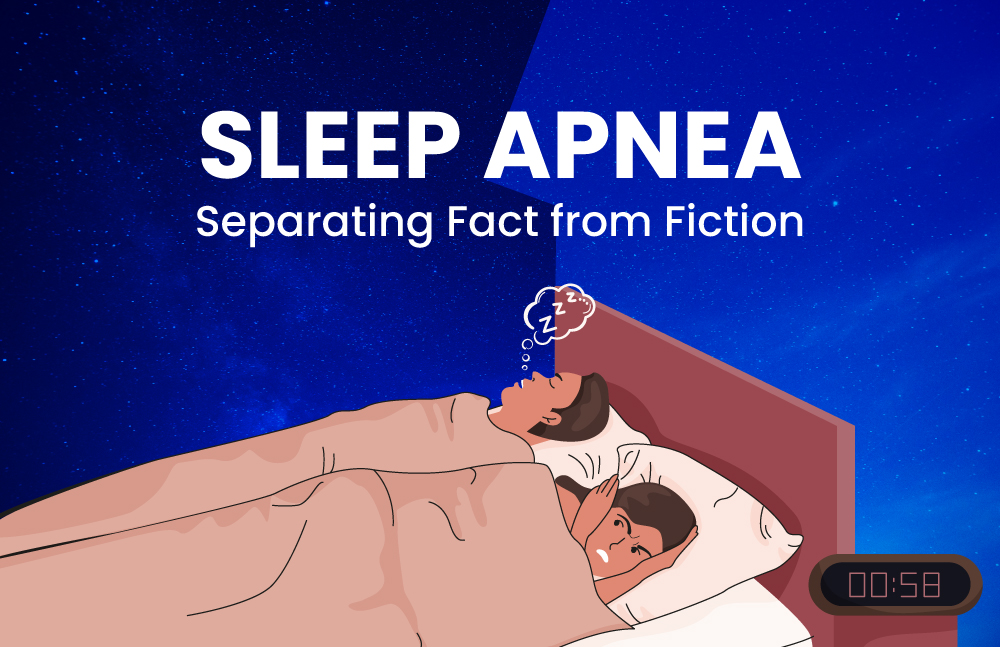
Sleep Apnea Myths and Facts That Everyone Should Know
Introduction
Sleep apnea is one of the most common yet misunderstood sleep disorders. From believing that only men snore to assuming CPAP is the only treatment, myths about sleep apnea can prevent people from getting the help they need.
In this blog, we’ll break down the most widespread misconceptions, share the facts behind them, and show you how modern solutions—from home sleep tests to non-invasive treatments—can help you sleep better and live healthier.
Table of content
Myth 1: Snoring Means I’m in Deep Sleep
Myth 2: If I Snore, I Definitely Have Sleep Apnea
Myth 3: Only Men Snore
Myth 4: Children Can’t Have Sleep Apnea
Myth 5: Only Overweight People Snore or Have Sleep Apnea
Myth 6: CPAP or Surgery Are the Only Treatments for Sleep Apnea
Myth 7: You Must Go to a Sleep Clinic for Diagnosis
1. Myth: Snoring Means I’m in Deep Sleep
Fact: Snoring usually signals disturbed sleep and may point to sleep apnea
Many people believe that snoring is a sign of deep, restful sleep, but the opposite is true. Loud, persistent snoring often means your body is struggling to breathe properly during the night. This could be a symptom of Obstructive Sleep Apnea (OSA)—a condition where breathing repeatedly stops, forcing you to wake up gasping for air. These constant interruptions prevent you from reaching restorative sleep, leaving you tired and drained during the day.
2. Myth: If I Snore, I Definitely Have Sleep Apnea
Fact: Not all snorers have sleep apnea
Snoring can be a symptom of OSA, but not everyone who snores has the condition. OSA occurs when the airway is blocked during sleep, causing choking, gasping, or pauses in breathing. It can also lead to dry mouth, headaches, and daytime sleepiness.
On the other hand, some people simply have “primary snoring” without apnea, while others may suffer from “silent apnea” without snoring at all.
3. Myth: Only Men Snore
Fact: Women also snore and are equally at risk for sleep apnea
Snoring is often thought of as a “men’s problem,” but many women snore too—and they can also develop sleep apnea. Hormonal changes during pregnancy, menopause, or conditions like PCOS can increase the risk. Women’s snoring tends to be softer, so it may go unnoticed, but other symptoms like insomnia, headaches, mood swings, and daytime fatigue can signal trouble.
4. Myth: Children Can’t Have Sleep Apnea
Fact: Sleep apnea can affect people of all ages, including kids
Sleep apnea is not limited to adults. Children—and even infants—can experience it too. In kids, persistent snoring may cause mood swings, irritability, hyperactivity, and difficulty focusing in school. Over time, untreated sleep disorders in children can affect growth and overall development.
5. Myth: Only Overweight People Snore or Have Sleep Apnea
Fact: Weight is not the only factor—age, anatomy, and lifestyle also play a role
Excess weight can increase the risk of snoring and sleep apnea, but it’s not the only cause. Structural factors like a narrow airway, enlarged tonsils, a small jaw, alcohol use, smoking, or even genetics can trigger snoring.
This means that thin, healthy people can also suffer from sleep apnea. While weight loss may help, it does not always solve the problem.
6. Myth: CPAP or Surgery Are the Only Treatments for Sleep Apnea
Fact: CPAP is effective, but alternatives like oral devices also work
Continuous Positive Airway Pressure (CPAP) therapy is a common treatment, but many patients find the mask uncomfortable. Surgery is another option, but it’s invasive and not suitable for everyone. The good news is that Mandibular Advancement Devices (MADs), such as SNOREKA from Dormir Bien, provide a comfortable, quiet, and travel-friendly alternative. These oral appliances reposition the jaw to keep the airway open, improving sleep without the hassle of a mask .
7. Myth: You Must Go to a Sleep Clinic for Diagnosis
Fact: Home sleep tests are now a reliable alternative
Traditionally, diagnosing sleep apnea meant spending a night in a sleep lab connected to wires—a process that’s often inconvenient and expensive. Today, home sleep tests offer a simpler solution. Devices like the Fastnap Sleep Band track your sleep patterns accurately from home, making it possible to detect apnea without leaving your bed. They’re portable, non-invasive, and easy to use.
Conclusion
Sleep apnea is often misunderstood, and these myths can delay people from getting the help they truly need. By separating fact from fiction, you can take informed steps toward protecting your health, improving sleep quality, and reducing long-term risks. If you or someone you know experiences symptoms such as loud snoring, pauses in breathing, or persistent fatigue, don’t ignore them—consult a healthcare professional. The right diagnosis and treatment can make a world of difference, helping you breathe easier, sleep better, and live healthier.


